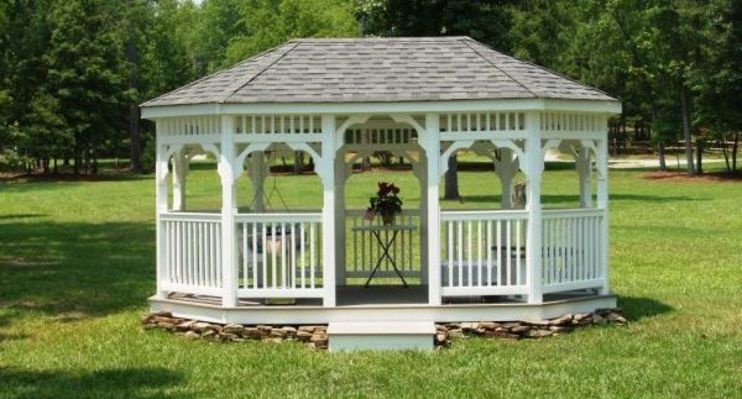Octagonal Gazebo Blueprints
Plans To Build 10 Feet Octagonal Pergola : Points To Look at When Assembling A Garden Pergola

For example, to maintain the natural appeal of wood, you will need to seal it to prevent it from graying. For these reasons, they cost more than wood but may be worth it for the ease of care. Check to make sure the cupola looks centered from the ground. It's made entirely of cedar wood with a natural and light finish. Bamboo, which never rots, can also be used as paneling in place of the cedar board. Make sure you countersink the head of the screws, otherwise (https://www.squaregazeboplans.com/gazebo-blueprints) they would be visible. Then after finding the halfway measurement of our upvc double doors, we lined those measurements up and where the end started.
You can adjust the gaps between the shade elements, as to fit your needs and tastes. Stand on the pavers once you have a few rings placed and have a helper pass or throw you the next half-dozen rings. There's a lot of weight there, and having it come crashing down would be a bad, bad thing. You know, this hasn't quite turned out that way. Patios and decks have had their time in the sun. Fill the tube forms with concrete and let it dry out for a few days. Cut each slat to length and apply two coats of stain.
You can research online for pergola plans and materials needed and read more on the appropriate dimensions. The traditional Italian pavilion (official website) was an ornamental outdoor structure situated in the garden. Use warm water, mild soap and a soft-bristle brush, then rinse with a hose. Next, the osb to cover the roof with. This would allow water to flow behind the ledger. Or you can hold the square in place and use it as a sturdy guide for running a portable circular saw. Gazebos are less commonly covered with vines, though they usually have beds around them in which flowers grow.
Procesando video...
As a cheaper alternative, we took a standard 12 x15 painter's tarp and cut that into equal strips. If you are about to build a summer house on your own property, have a look at the development plan for your property at your local planning office. The struts ties are needed due to the size of the shade elements, so they would really reinforce the joints. Place a piece of wood between the balusters, as to get consistent results. Then attach the soffit to the corner supports just as you attached the sill. Clear all the vegetation from the location of the pergola.
Where you have had chance to dry out your boards prior to installation, you should leave between 7-10mm gap between boards. Rest the beam onto the temporary supports. Notch the posts to receive the first stringer. Fill the holes with wood putty and then smooth the surface with sandpaper. Then move the temporary braces for the next ridge board and continue installing rafters. Use a wrench to tighten the lag screws. Measure from the top of the finished arbor floor straight down to the ground. It has to be done correctly to help support the wall. A framing square is traditionally used for laying out the roof and determining pitch.
Using a hammer or nail gun, fix the rafters on top of beams with long nails hammered diagonally to the vertical line. After two of three months, check the bolts, nuts and lag screws. Install the center support for the deck. Squeeze out an exterior-rated glue on one of the pieces and clamp the other piece to it. For example, the square footage of a 10-by-10-foot garden is 10 times 10 or 100 square feet. You could use a suitable roofing repair such as some felt repair adhesives available in various hardware stores. Simple roofs, such as a shed or the common gable, are fairly easy to construct, even without plans, if you understand the basics and a little geometry.
Repeat this action until all eight columns are marked. You can add these at the very end, once all the other pieces are in place. This time, Dennis keeps his eye on the level. For a basic, small deck, you could probably get away with using just three joists. In most cases, 4 by 4 columns would carry the needed weight but may look spindly- a 6 by 6 might offer a stronger look. So even though the gazebo is already there, the details are basically the same from digging to decking. It's an affordable way of enhancing your landscape without leaving you with a significant dent in your pocket.